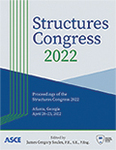Investigation of the Rotation Capacity and Flexural Strength of Web Tapered Hybrid High Strength Steel Simple Supported I-Section
Publication: Structures Congress 2022
ABSTRACT
Understanding the behavior of structural steel in terms of fabrication and fashioning is an important factor in the design of steel structures. The search for structural steel with capabilities of acceptable responses in seismic regions alongside cost efficiency has led to the investigation of the behavior of high strength steels (HSS), which have a yield strength of 55 ksi (ASTM A572) or higher, as classified by US standards, while their inelastic capacity is less than that of conventional steel. The present research investigates the rotation capacity and flexural strength of hybrid high strength web-tapered I-shaped steel girders using an experimentally verified nonlinear finite element modeling technique. The academic multipurpose software package ANSYS19.2 was used to develop a finite element model, and a mesh convergence study was performed to ensure the accuracy of the results. Geometrical imperfections were applied to conduct a linear eigenvalue analysis and to capture buckling mode shapes to perform a nonlinear analysis. The residual stress was associated in the finite element model for different welding configurations. The numerical model was verified with previous experimental data, and close agreements were achieved. A total of 450 models were used to perform a parametric study with various flange and web slenderness as well as lateral bracing configurations to capture local, overall, and local-overall buckling modes. As results, some equations for direct design of non-prismatic hybrid high strength steel girders were proposed.
Get full access to this article
View all available purchase options and get full access to this chapter.
REFERENCES
Salmon, C. G., and Johnson, J. E. (1996). Steel Structures, Design and Behavior, Fourth Edition, HarperCollins College Publishers, New York, New York.
American Institute of Steel Construction (AISC). (1999). Load and Resistance Factor Design (LRFD) Specification for Structural Steel Buildings, Chicago, Illinois.
ASCE. (1971) Plastic Design in Steel, A Guide and Commentary, American Society of Civil Engineers, New York, New York,
ANSYS. (2001) ABAQUS Standard User’s Manual, Version 5.8, Volumes 1 to 3, Hibbit, Karlsson & Sorensen, Inc., Pawtucket, Rhode Island, USA.
Kim, Y. (2010). “Behavior and design of metal building frames using general prismatic and web-tapered steel I-section members”.
Kim, Y., and D. White. (2006a). Benchmark Problems for Second-Order Analysis of Frames with Tapered-Web Members., Atlanta, GA:, School of Civil & Environmental Engineering.
Kim, Y., and D. White. (2006b). Full Nonlinear Finite Element Analysis Simulation of the LB-3 Test from Prawel et al. (1974)., Atlanta, GA:, School of Civil & Environmental Engineering.
Kim, Y., and D. White. (2007a). “Practical Buckling Solutions for Tapered Beam Members”. In: Annual Technical Session, Structural Stability Research Council. Ed. by M. University of Missouri Rolla
Kim,Y., and D. White. (2007b). Assessment of Nominal Resistance Calculations for Web-Tapered I-shaped Members: Comparison to Experimental Tests and to Finite Element Simulations of Experimental Tests., Atlanta, GA:, School of Civil & Environmental Engineering.
Firoz, S., S. Kumar, and S. Rao (2012). “Design Concept of Pre-Engineered Building”. In: International Journal of Research in Applications.
Lee, G., and M. Morrell. (1975). “Application of AISC design provisions for tapered members”. In: Engineering Journal
Lee, G., M. Morell, and R. Ketter. (1972). Design of Tapered Members. DTIC Document.
Newman, A. (2004). Metal building systems: design and specifications. McGraw-Hill Professional
Ozgur,C., Y. Kim, and D. White. (2007). Consideration of End Restraint Effects in Web-Tapered Members., Atlanta, GA:, School of Civil & Environmental Engineering.
Timoshenko, S., and J. Gere. (1961). “Theory of elastic stability.1961”.In:McGrawHill-Kogakusha Ltd, Tokyo
White, D. (2006). Structural Behavior of Steel., Atlanta, GA:, School of Civil & Environmental Engineering.
White, D., and Y. Kim. (2006). “A Prototype Application of the AISC (2005) Stability Analysis and Design Provisions to Metal Building Structural Systems”. In: Report to Metal Building Manufacturers Association, School of Civil and Environmental Engineering, Georgia Institute of Technology, Atlanta, GA, September.
White, D., and C. Chang. (2007). “Improved Flexural Stability Design of I-Section Members in AISC (2005) - A Case Study Comparison to AISC (1989) ASD”. In: Engineering journal
Winter, G. (1960). “Lateral Bracing of Columns and Beams,” Transactions, ASCE, Vol. 125, pp. 807–845.
Earls, C. J. (2001). “Constant moment behavior of high-performance steel I-shaped beams.” Journal of Constructional Steel.
Ban, H., G. Shi, Y. Shi, and Y. Wang. (2012). “Overall buckling behavior of 460MPa high strength steel columns: Experimental investigation and design method”. Journal of Constructional Steel Research.
Shokouhian, M., and Y. Shi. “Investigation of Ductility in Hybrid and High Strength Steel Beams.” International Journal of Steel Structures, vol. 14, no. 2, June 2014.
Duan, L., et al. “Shear Resistance Study of Hybrid I-Beams Fabricated by HPS 485W and Q345 Steels.” Advanced Materials Research, vol. 255, no. 1, 31 May 2011.
Shokouhian, M., and Y. Shi. “Flexural Strength of Hybrid Steel I-Beams Based on Slenderness.” Engineering Structures, vol. 93, 15 June 2015.
Charney, F. A., and O. Atlayan. “Hybrid Moment-Resisting Steel Frames.”Engineering Journal (00138029), vol. 48, no. 3, 2011.
Deformation capacity of high-strength steel members Suzuki, Toshiro/Ono, Tetsuro.
Lee, G. C., M. L. Morrell, and R. L. Ketter. 1972. “Design of Tapered Members,” WRC.
Lee, C.-H., et al. “Flexural Strength and Rotation Capacity of I-Shaped Beams Fabricated from 800-MPa Steel.” Journal of Structural Engineering, vol. 139, no. 6, June 2013.
Bending and Buckling Strength of Tapered Structural Members. S. P. PRAWEL, M. L. MORRELL AND G. C. LEE 1974.
Information & Authors
Information
Published In
History
Published online: Apr 18, 2022
Authors
Metrics & Citations
Metrics
Citations
Download citation
If you have the appropriate software installed, you can download article citation data to the citation manager of your choice. Simply select your manager software from the list below and click Download.
